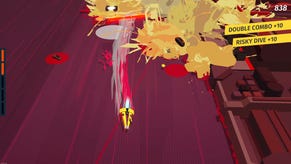Trends of 2013: Rise of the indies
How the changing industry has created a perfect storm of indie development.
2013 will be the year when indie developers reclaim their rightful place as the creative engine of the industry. I'm not going to claim any great powers of prognostication for this one, since it really feels like stating the obvious, so much so that it barely even qualifies as a trend, which suggests a fleeting fad to be seized, exhausted and abandoned. This is more of an inexorable march, the inevitable result of the commercial entropy that is demolishing the games industry systems that have endured for over twenty years.
Indie gaming has always been around, but 2012 felt like a tipping point where what had been a hobbyist niche finally matured into a legitimate, if charmingly eccentric, arm of industry.
Indie's rise has been a slow and steady affair, but there's little doubt that it has accelerated in recent years. What crystallised it for me was the realisation while compiling my own Best of 2012 list and comparing it to those of my peers that the usefulness of "indie game" as a label may soon be redundant. More than any previous year, the lists were a truly eclectic mixture of high profile mainstream console releases, quirky downloadable tiles and all points in between. Nothing felt like a token entry, there was no patronising seat at the big boy table reserved for an duly anointed indie title. Every game deserved its praise and success, regardless of the vast gulf in resources poured into their construction.
It's clearer than ever that this is no mere blip, and far more than a fanciful flirtation with pixel art and chiptune music. This is where the industry is headed, the result of multiple strands of change all pulling in the same direction. In some cases indie gaming has been the cause, in others the effect, but the destination is an industry - and a medium - forever changed.
It's to do with the rise of mobile, of course. Even just five years ago there were plenty who scoffed at the idea of playing on phones ever making a serious dent in gaming. Games were big things in boxes that you bought from shops, on discs that you slid into expensive electronic boxes connected to TVs and monitors. No matter how many people insisted it was an explosion waiting to happen, there were those who preferred to cosplay as King Canute and ignore the tide lapping around their feet.
The ones who reacted first and reaped the rewards were generally those who weren't mired in vast corporate machines - the indies. When the iPhone came along, and later the iPad and the tablet boom, it was the industry giants that stumbled and struggled to navigate the sudden change in direction while small companies took the beach head and planted the first flags in virgin soil.
It's to do with the rebirth of the PC as a leading games platform as well. Just as the blinkered scoffed at the idea of mobile gaming becoming big business, so they insisted that the PC was dead as a games platform, pointing to poor sales and dwindling shelf space in bricks and mortar retailers and rampant piracy. The AAA games were developed with consoles in mind, with PC ports often late, lazy and lacklustre. Once again, it was the smaller developers and studios, the enthusiasts, the indies, who not only stayed the course but developed and seized new distribution channels and commercial models, bending a supposedly moribund platform back into the creative hothouse of the industry.
It's to do with crowdsourcing, a trend within a trend, that may revolutionise the way indies operate provided the community's goodwill isn't burned out by expensive, name-brand ringers. And it's to do with the decline of physical retail and the rapid ascent of digital, another seismic shift that caught the sluggish publishers off guard, trapped between their desire to cut costs and their inability - or unwillingness - to risk upsetting the high street retailers who had been their workhorses for so long. Again, it was the innovators and creators who took the advantage, agile mammals nipping between the legs of lumbering dinosaurs as the environment shifted in their favour.
All of these things are important on their own, but combined they have created a perfect storm of indie development. That's why we're seeing more small start-ups and idealistic coding teams than at any time since the 1980s. Back then, even the most ambitious bedroom coder still had to find a way to get their games on tapes or discs and into the hands of players. Today, all you need is a website or a copy of Xcode and an Apple login.
Development has swung hard in the direction of the indie model, just as distribution has been thrown open into a chaotic worldwide digital soup. It's not quite a meritocracy, and visibility is inevitably a problem, but it's technically never been easier for an aspiring developer to get their wares into the hands of an appreciative audience, whether they live in the next street or the other side of the world.
That's why every week brings news of more small teams breaking off from major developers, or emerging from the ashes of some beloved shuttered studio, closed before its time to balance the books further up the food chain. Thousands of creative people, their heads brimming with ideas that would never have seen the light of day in an environment driven by milestones and sequels, set free to realise their vision by any means necessary. Not great for their financial security but, selfishly, absolutely great for the medium of games and for us as gamers. Some will fall flat on their faces. Most will struggle. A few will become millionaires. Out of the turmoil will come original ideas, bold concepts and the shape of the industry of the future.
It's a change that's long overdue. The so-called mainstream games industry is in crisis, not just an economic crisis caused by the disappearance of the middle tier of game sales, but a creative crisis brought about by stagnant markets, corporate timidity and conservative business practices. The last few months of 2012 brought the traditional slew of high profile sequels, but precious little lasting excitement.
This is the 8/10 limbo, a lucrative but inert wasteland of technically proficient and highly polished games that are ruthlessly efficient at what they do, but no more nourishing in the long term than a carb-heavy meal from a high street restaurant chain. They may earn their asking price in entertainment provided, but few people will cling to them as their favourite games of all time, the games that made them fall a little bit more in love with games as a creative medium rather than just a way of filling spare time.
For that you need the eccentric spark that now only flourishes outside of that hermetically sealed blockbuster system. You need flexibility, freedom and leftfield thinking. You need the indies.
There have been breakout hits and surprise successes from that scene, of course, but I sense a critical mass being reached. Indie is now more than just an affectionate label or an aesthetic shorthand. It's a viable and vital alternative for the ground troops on whose backs the industry marches. The blockbusters will always be around, and will always slurp up the lion's share of the money and attention, but their dominance is no longer quite so assured.
Time was, you could predict the best games of the year ahead by taking your favourite title from last year and sticking a number on the end. That doesn't work any more. The best games of 2013 are the ones that we haven't even heard about yet. They probably haven't even started production and we've almost certainly never heard of the people making them. That, more than any other change in this turbulent time, is what keeps me excited for 2013 and beyond.
























